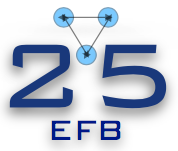Speaker
Description
The attractive nature of $\bar{K}N$ interaction has stimulated theoretical and experimental searches for $K^-$ bound states in different systems. In particular, many theoretical calculations devoted to the lightest possible system $\bar{K}NN$ were performed using different methods. All of them agree that a quasi-bound state in the $K^- pp$ system exists, but they yield quite diverse binding energies and widths. The experimental situation is unsettled as well: several candidates for the $K^- pp$ state were reported by some experimental groups, but the estimated binding energies and decay widths of such state differ from each other and are far from all theoretical predictions. In particular, the most recent E15 experiment at J-PARC [1] reported the first clear signal of the $\bar{K}NN$ quasi-bound state with binding energy $42 \pm 3 (\rm stat.) {}^{+3}_{-4} (\rm syst.)$ MeV, and width $100 \pm 7 (\rm stat.) {}^{+19}_{-9} (\rm syst.)$ MeV.
In previous years we studied the quasi-bound state in the $K^- pp$ system, the most recent results can be found in [2]. Faddeev-type dynamically exact three-body AGS equations [3] with coupled $\bar{K}NN - \pi \Sigma N$ channels were solved with different input. Three models of the $\bar{K}N$ interaction were used, and two of them led to $K^- pp$ binding energies close to the experimental values. However, the experimental width is much larger than ours. The present calculations aim to check, what could change the theoretical characteristics of the quasi-bound state. We will study the dependence of the results on the $\Sigma N - \Lambda N$ interaction models, on $\pi N$ potential, which was excluded in the previous calculations, and will perform three-body calculations with three coupled channels: $\bar{K}NN$, $\pi \Sigma N$, and $\pi \Lambda N$.
[1] T. Yamaga, EPJ Web Conf. 271, 07001 (2022).
[2] N.V. Shevchenko, Few\ Body\ Syst. 61, 27 (2020).
[3] E.O. Alt, P. Grassberger, W. Sandhas, Nucl. Phys. B2, 167 (1967).

